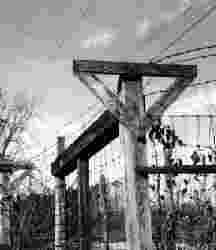|
Old POW Camp Just A Memory |
|
It had been 40 years since Peter von
Seildein of Stuttgart, Germany, had been in central Indiana but last
month he returned to an area where he lived for almost two years,... as
a prisoner of war. Now a professor of architecture at Stuttgart
University, von Seidlein was in Columbus last month as part of a
university tour group studying the city's architecture. Forth years
earlier, he was at Camp Atterbury as a prisoner of war. While in
Columbus he met Graziella Bush, director of the Visitor's Center. On
arriving back in Germany, he wrote her detailing the experiences of a
German soldier serving as a prisoner of war at Atterbury. Some of those
memories are reprinted here. From: Peter C. von Seidlein, Professor
of Architecture, University of Stuttgart, Germany To Graziella Bush, Visitors Center,
Columbus Thank you so much for sending me
"The Atterbury File." When it arrived last week I was rather
busy, but at 6p.m. I started to read the book and by 10 p.m. I had
finished it. Naturally it was the chapter on the
POW camp which interested me most. But there were also some other parts
I found most interesting, especially the one on life in the area before
it became a military camp in 1942. When I was working with a detail
cutting trees in the winter of 1944-45, we once spent much time in a
deserted 19th century farmhouse. I always wondered what
became of the farmers. When I arrived at Camp Atterbury in
the middle of September 1944 (I was wounded and taken prisoner on August
20th in Normandy) life in the POW camp was heaven. We
received a new U.S. Army outfit, got as much to eat as we could eat and
slept in a bed with a mattress. There were no German officers and no
non-commissioned officers in Camp Atterbury, except for a short period
of time when a few hundred officers passed through, which was probably
late in 1945. The first few months I was working in one of the 12
kitchens within the POW camp, but I found this rather tiresome and
volunteered for work outside the camp. There is hardly a menial job I didn't
do during the next year; picking tomatoes and apples, working in a
slaughterhouse, driving a tractor, pressing shits and trousers, washing
dishes and so on. Some of this work was done as far south a the Kentucky
border and some as far north as Indianapolis. During the winter I was orderly in an
officers' club in Camp Atterbury, cleaning up the club and serving on
the bar. My last POW job was interpreting for an "ash and
trash" detail, which had to clean up barracks after they were left
by discharged soldiers - one of the most sought after jobs as the GIs
left all and everything they couldn't carry with them in the barracks. I left Camp Atterbury after almost 22
months with the last transport late in June 1946, got on board a Liberty
freighter in New York, arrived in Le Havre early in July 1946 and stayed
at another POW camp, at Bolbec, afraid of being handed over to the
French to work in a coal mine for another two years. Eventually we were
put on a train to be discharged in Nuremberg on the 20th of
July 1946. Altogether there were 400,000 German POWs in the USA from 1942 to 1946. The military used the troop ships going back to the US for this purpose. I think that this was an excellent idea. The German POWs who were in America became friends of the United States, saw what democracy is like and told what they had seen to their friends and families when they came back. |
 Page last revised
09/01/2022 Page last revised
09/01/2022James D. West www.IndianaMilitary.org Host106th@106thInfDivAssn.org |
 40
Years Later, Ex-POW Remembers Atterbury
40
Years Later, Ex-POW Remembers Atterbury